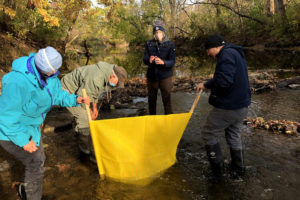2020: Despite everything else, a productive year for water monitoring
by Watershed Educator Dan Haug
It’s been almost a year since Story County Conservation, Story County Supervisors, the City of Ames, and the Leopold Center for Sustainable Agriculture and Story County Community Foundation funded a project to launch a countywide monitoring program and to support data collection and outreach. 2020 was a challenging year, so it’s no surprise we’re not quite done with the planning document itself. What is surprising is how much else PRI and our partners have achieved in the past 12 months.
Representatives from the Izaak Walton League of America, Story County Soil & Water, City of Gilbert, City of Nevada, and the City of Huxley joined the planning team for a lively discussion of why we value local water bodies and how we can better work together to understand and improve water quality. Two of the partners (City of Ames and City of Nevada) were awarded SRF Sponsored Projects to address water quality in town through stream restoration and stormwater management practices. Congrats! …Read more about the partnership.
October 2020 Watershed Awareness Month
In addition to the proclamations and social media outreach by multiple jurisdictions, PRI and the City of Ames worked together to launch two educational videos.
What is a watershed (stormwater)?
The South Skunk River watershed
Expanded Volunteer Water Monitoring
Already 15 volunteers have signed up with Story County Conservation to do regular testing of streams around the county.
The Izaak Walton League’s Save Our Streams program is supporting volunteer monitoring in Iowa through training events, a database, and fun entry points Stream Selfie and Winter Salt Watch.
PRI organized two socially-distanced “snapshot” events in the Squaw Creek (now Ioway Creek) watershed and beyond.
- Spring 2020, 28 volunteers
- Fall 2020, 13 volunteers
Expanded Lab Testing
Thanks to the support of the City of Ames Water and Pollution Control Laboratory, we’ve been able to collect monthly samples from 15 streams around the county.
Concerned by the E. coli numbers? …Read more for context.
Understanding the Wealth of Data We Already Have
I learned the computer programming language “R” to take a deep dive into our existing pool of data. This pool was much deeper than anyone realized including:
- 3 nitrate sensors, maintained by USDA and IIHR.
- 18 years of weekly monitoring in the South Skunk River, collected by City of Ames.
- We’ve used this data to interpret short-term trends. Nitrate concentrations have dropped dramatically in the past 7 years, but phosphorus trends are flat.
- We then used the data to interpret longer term swings in nitrate, an effect we’re calling “weather whiplash!” We expect nitrate to go up again in the next year or two, unless the pace of conservation picks up.
- 20 years of monthly data from DNR on the South Skunk River below Ames and dozens of other sites measured less frequently
- Over 10,000 records and 265 different chemicals. Now that we know what’s available, we can use it as a baseline when returning to an old site, or as a reference when sampling an upstream site.
Making the Case for Long-Term Water Monitoring
The idea behind a 10-year monitoring plan is to make sure that we sample often enough or long enough to tell us something useful.
- Some of the same difficulties that have undermined confidence in public opinion polling this election season apply to water monitoring, so we’re working to get ahead of the issue and budget our resources accordingly.

